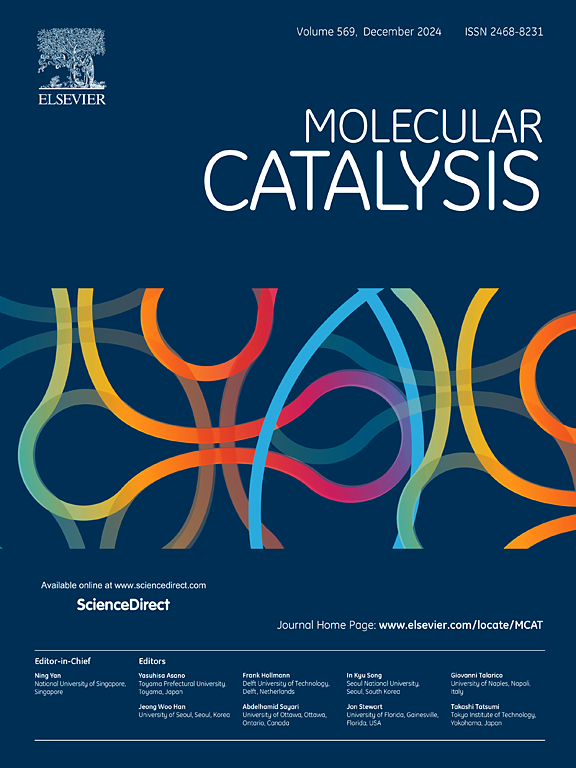利用新的恶性醋酸杆菌菌株将苯甲醇衍生物氧化成羧酸:提高连续流动系统的生产率
IF 3.9
2区 化学
Q2 CHEMISTRY, PHYSICAL
引用次数: 0
摘要
利用新分离的菌株 Acetobacter malorum DSM 112354 实现了将不同的苯甲醇衍生物一次性绿色氧化成相应的羧酸。以 8 小时后的生产率作为反应参数,对苯甲醇的氧化进行了初步优化。在优化条件下,对一组对位取代的苄醇进行了测试,结果表明恶臭乙酸杆菌 DSM 112354 具有极大的多功能性,能够氧化所有底物,尽管氧化速度和转化率各不相同。随后,以 2-(羟基甲基)苯酚、3-(羟基甲基)苯酚和 4-(羟基甲基)苯酚为起始原料,研究了取代基位置的影响,结果表明所有底物都能被高效转化(2-24 小时内的摩尔转化率为 74-98%)。最后,1,4-苯二甲醇氧化生成 4-(羟甲基)苯甲酸的过程具有极佳的区域选择性,因为观察到对苯二甲酸的比例为 3%。在一个连续的多相流反应器中,使用固定了钡-精氨酸的恶性醋酸杆菌 DSM 112354 细胞对这一区域选择性反应进行了优化。连续运行 24 小时后,使用 14.4 mL 反应器可获得 0.65 g HMBA。这种强化与生物催化剂生产率(37.1 mmolP/细胞干重)和时空产量(45.1 mgP/mL d)的提高有关。本文章由计算机程序翻译,如有差异,请以英文原文为准。
Oxidation of benzyl alcohol derivatives into carboxylic acids with a new Acetobacter malorum strain: boosting the productivity in a continuous flow system
The one-shot green oxidation of different benzyl alcohol derivatives into the corresponding carboxylic acids was achieved by using Acetobacter malorum DSM 112354, a newly isolated strain. Oxidation of benzyl alcohol was initially optimized considering productivity after 8 h as response parameter. Under optimized conditions, a set of para-substituted benzyl alcohols was tested, showing the great versatility of Acetobacter malorum DSM 112354 which was able to oxidize all the substrates albeit with different rates and conversions. The effect of the substituent position was subsequently studied using 2-(hydroxymethyl)phenol, 3-(hydroxymethyl)phenol, and 4-(hydroxymethyl)phenol as starting materials, showing that all the substrates were efficiently transformed (74-98% molar conversion in 2-24 h). Finally, the oxidation of 1,4-phenylenedimethanol gave 4-(hydroxymethyl)benzoic acid proceeded with excellent regioselectivity, since <3% of terephthalic acid was observed. This regioselective reaction was optimized using Ba-alginate immobilized cells of Acetobacter malorum DSM 112354 in a continuous multiphasic flow reactor. The process continuously run for 24 h allowed the obtainment of 0.65 g of HMBA using a 14.4 mL reactor. This intensification was associated with upgraded biocatalyst productivity (37.1 mmolP/gcells dry weight) and space-time yield (45.1 mgP/mL d).
求助全文
通过发布文献求助,成功后即可免费获取论文全文。
去求助
来源期刊

Molecular Catalysis
Chemical Engineering-Process Chemistry and Technology
CiteScore
6.90
自引率
10.90%
发文量
700
审稿时长
40 days
期刊介绍:
Molecular Catalysis publishes full papers that are original, rigorous, and scholarly contributions examining the molecular and atomic aspects of catalytic activation and reaction mechanisms. The fields covered are:
Heterogeneous catalysis including immobilized molecular catalysts
Homogeneous catalysis including organocatalysis, organometallic catalysis and biocatalysis
Photo- and electrochemistry
Theoretical aspects of catalysis analyzed by computational methods
 求助内容:
求助内容: 应助结果提醒方式:
应助结果提醒方式:


